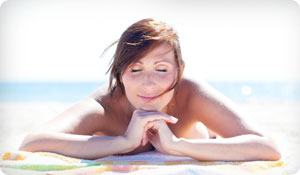
We all require some sun exposure. In fact, it's the body's primary source of vitamin D. But the problem lies in repeated, unprotected exposure to the sun's ultraviolet A (UVA) and ultraviolet B (UVB) rays. What is it about these rays, though, that makes them so harmful? And how can you tell if you're taking the proper safety precautions?
UVA Rays: Think "A" for Aging
UVA wavelengths deeply penetrate the dermis and subcutaneous layers of your skin. These skin layers are located beneath the epidermis, the top layer of your skin. UVAs damage collagen and elastin-resulting in premature aging and wrinkling. Even though UVA rays pass the first layer of skin, where most skin cancers appear, these rays can still damage the basal and squamous cell layers of the epidermis and cause skin cancers such as basal cell carcinoma and squamous cell carcinoma.
UVA rays exist year-round and can penetrate through windows, clothing, and even clouds. But tanning booths are way worse. The high-pressure sunlamps located in tanning salons release doses of UVA that are 12 times more prominent than what the sun emits. According to the Skin Cancer Foundation, those who tan indoors are 2.5 times more likely to develop squamous cell carcinoma and 1.5 times more likely to develop basal cell carcinoma.
UVB Rays: Think "B" for Burning
UVB wavelengths don't penetrate beyond the epidermis. These rays are 90 percent responsible for the visible redness and pain associated with sunburn. The SPF number marked on sunscreen generally indicates the UVB protection level.
Overexposure to these damage-inducing rays can increase your risk for cancer in the epidermal layer of your skin. According to the Skin Cancer Foundation, UVB rays are more likely to induce skin damage between 10:00 a.m. to 4:00 p.m. in warm weather and even in winter. This is because UVB rays reflect off of snow and ice in high altitudes, hitting the skin twice. But unlike UVA rays, UVB can't penetrate glass.
Ingredients to Look Out For
All sunscreens come with UVB-blocking ingredients. The level of protection depends on the SPF number for that sunscreen. SPFs of 15 to 50 are the best range to ensure adequate UVB protection. But for UVA protection, make sure that the label says "multi-spectrum," "broad-spectrum," or "UVA/UVB protection." However, some labels can be misleading, so make sure the sunscreen's active ingredients list includes a combination of the following UVA-protective agents:
- Avobenzone
- Ecamsule
- Oxybenzone
- Titanium dioxide
- Zinc oxide
Sunscreen application isn't the only measure you should take when guarding against premature aging and skin cancer. Here are some additional guidelines from the Skin Cancer Foundation:
- Seek shade between 10:00 a.m. and 4:00 p.m.
- Do not get sunburned.
- Avoid tanning, both indoor and outdoor.
- Cover up and used broad-brimmed hats and UV-blocking sunglasses.
- For everyday activities, use broad-spectrum sunscreen with an SPF of 15 or higher.
- For extended outdoor activity, use water-resistant, broad-spectrum SPF of 30 or higher.
- Apply two tablespoons of sunscreen to your entire body 30 minutes before going outside.
- Reapply sunscreen every two hours or immediately after exposure to water, including swimming and excess sweating.
- See your doctor every year for a professional skin exam.
- Examine your skin from head-to-toe monthly to check for new moles and marks. Visit your doctor if you find any new marks or any changes to your current ones.
Source:
Understanding UVA and UVB
http://www.skincancer.org/understanding-uva-and-uvb.html





